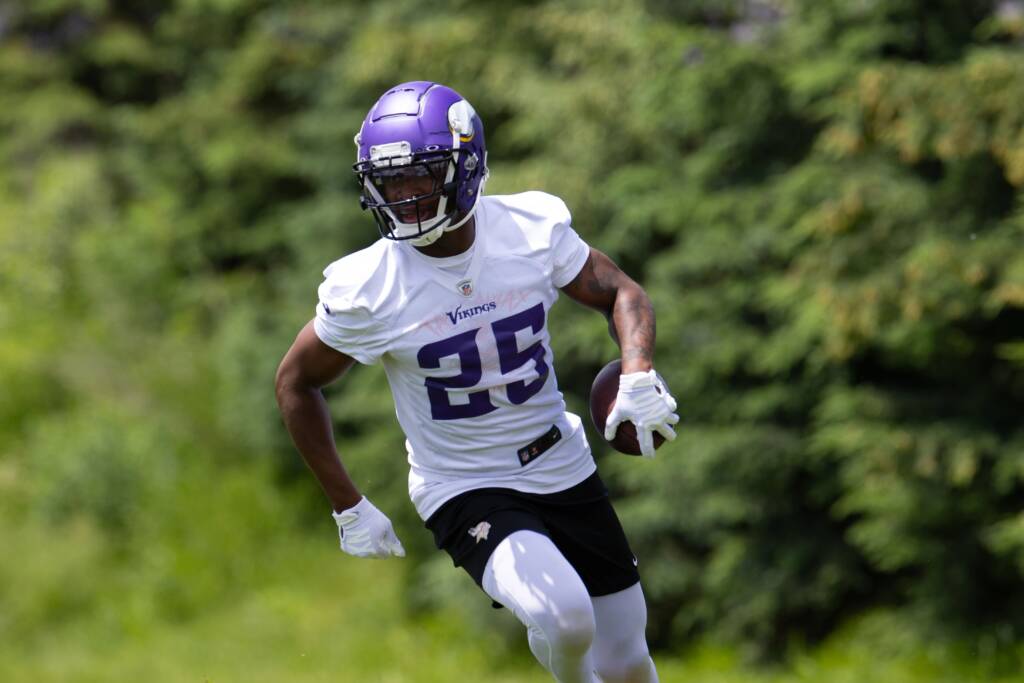If you spend enough time around an NFL run game, you’ll eventually hear about something called “The B Gap Bubble.” It’s an important weakness in any team’s four-down front, and in my opinion, attacking it is the key to beating the New York Giants on Sunday. The Giants will no doubt be tempted to attack the Minnesota Vikings’ two backup offensive linemen (Garrett Bradbury pending). How they prefer to do that, and how that strategy can be countered, is a key thing to watch.
If you’re unfamiliar with the “bubble” in a given defensive front, think of it visually. When there are four down linemen, they have to leave one gap uncovered. The defense will usually line a linebacker up in that gap but off the ball. In typical “over” or “under” fronts, that gap will be a “B” gap — between the tackle and guard. It becomes a relatively weakly defended spot on the line of scrimmage.

Offenses love to run at the B-gap bubble. In fact, during wild-card weekend, here’s a side game you can play. Listen for the quarterback to yell either “Can Can” or “Kill Kill.” That means the offense is changing from a called play to a backup play. This is particularly common if the offense called a screen or long-developing play-action play but doesn’t like the look of the defensive alignment. It’s also common if the backup run would go to the B-gap bubble. If you hear “Can” or “Kill,” watch how often the offense runs at the B-gap bubble. Of course, a team can use “canned” plays to do many things, but that is a common one.
On Christmas Eve, the Giants played into this tendency, and it caused them a good deal of trouble — you can see it in the screenshot. They were trying to attack backup center Austin Schlottmann. New York is in an “over” front here. That means a 3-technique strong side and a 1-technique weak side. But that 1-technique, No. 97 Dexter Lawrence, is shaded further inside than usual. If the Vikings run to the strong side, he’ll have a head start on Schlottmann. Schlottmann will also have Lawrence in tighter quarters in pass protection, which advantages Lawrence.
The downside is that it widens that B-gap bubble. That frees up Cleveland to climb all the way up to the linebacker, and Dalvin Cook can just ride the wave to a six-yard gain.
The Giants might be even more keen to take this deal with a third-string center in, though. If Chris Reed has to start, that will be one of New York’s most favorable mismatches. Encouragingly, though, the Chicago Bears tried the same alignment (in a different front structure, but the block was the same). Armon Watts is no Dexter Lawrence, but this is an encouraging result:
Reed had a physically dominant game against whatever was left of Chicago’s roster. Of course, that comes with a massive grain of salt, but it’s something.
Kayvon Thibodeaux is the other factor. The Giants love putting Thibodeaux at a “wide 9” alignment. That means Thibodeaux lines up way outside the tackle, where all that extra space gives him an advantage thanks to his speed. This can be absolutely lethal, as the Washington Commanders found out in prime time:
This is especially scary against a player like Oli Udoh, who will start at right tackle. One of Udoh’s most consistent weaknesses is how much space he covers with his initial pass sets.
There are a few solutions to this. Udoh could just try to set with extra depth and width, but this is dangerous business. If it’s not comfortable, he could set too far, and Thibodeaux could beat him inside. Instead, the Vikings may want to put extra bodies to Udoh’s side. Don’t be surprised to see T.J. Hockenson line up to the right more often than the left in this game. Even if Hockenson isn’t chipping or blocking, it changes Thibodeaux’s alignment.
Usually, a “wide 9” is told to align outside the “ghost” tight end if there isn’t a real one. Essentially, pretend there is a tight end and align outside where that guy would be. With an actual tight end, or in the case of the below clip, two, it will push Thibodeaux further outside. That gives the matchup even more space than the Giants were trying to buy with their alignment. At a certain point, there are diminishing returns. If Udoh has that much more time to set up, he can reduce Thibodeaux’s advantage.
Here is an example of the Vikings using both tight ends on the same side to widen out the front even more. This is on the left side, against Azeez Ojulari, and it’s the C and D gaps instead of the B gap, but the principle is the same.
This allows Christian Darrisaw to climb to the second level unimpeded and engage with Micah McFadden, a fifth-round rookie. The results are exactly what you’d expect:
How the Giants approach this sort of Sophie’s choice is one of my biggest curiosities headed into the game. Will they widen out their 1-technique, abandoning their attempt to exploit Reed? Will they put Thibodeaux further inside, limiting their ability to take advantage of his biggest strengths? Will they keep Thibodeaux away from the strong side of the play, allowing him his preferred alignment but abandoning the Thibodeaux-Udoh mismatch? Or will they flatten out into more base fronts, leaving their depleted secondary without as much inside help?
You don’t need to be able to predict what the Giants do or whether it will work. If you are on the Vikings’ staff, maybe you do, but we just need to understand the dynamics for our purposes. So instead of getting upset every time the Vikings run the ball, look at which gap they are running to and how that leverages each player’s skill set.


